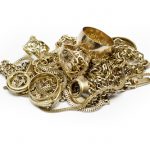The “Gold Rush” was sparked by the discovery of gold nuggets in Sacramento Valley in 1848. Thousands of prospective miners traveled to California by land and sea, extracting more than 750,000 pounds of gold, according to the History Channel.
They used a variety of tools to dig and sort the gold from the earth — from picks and shovels to gold pans and cradles (a rectangular wooden box, set at a downward angle and mounted on a rocking mechanism).
But there’s one resource they never utilized: ants and termites. Researchers recently discovered that the termite T. tumuli could successfully detect gold concealed below the surface. They made this discovery by testing the content of a nest, where gold was present.
Not all termites build their nests above the earth’s surface though. Some termites build large nests underground. These types of termites are very prevalent in areas of Australia where gold can be found.
As a result, researchers conducted studies to determine if these subterranean mounds indicated the presence of gold. They took samples from three different nests: mound-forming termites, subterranean termites, and an ant species.
Some of the locations selected were known to contain minerals, such as gold. Researchers also used sampling points where the content of the ground was unknown.
The study showed that ants were able to carry a higher concentration of gold to their nests compared to the mound-forming termites and the subterranean termites, up to 24.4 parts per billion of gold compared to 7.4 and 8.4 parts per billion.
It also revealed that the insects could vertically move gold, copper and zinc from at least 1.4m deep.
Could ants have helped early prospectors locate gold in the ground? Maybe. But today, their nests might help advance geochemical exploration.
Source: IFL Science











